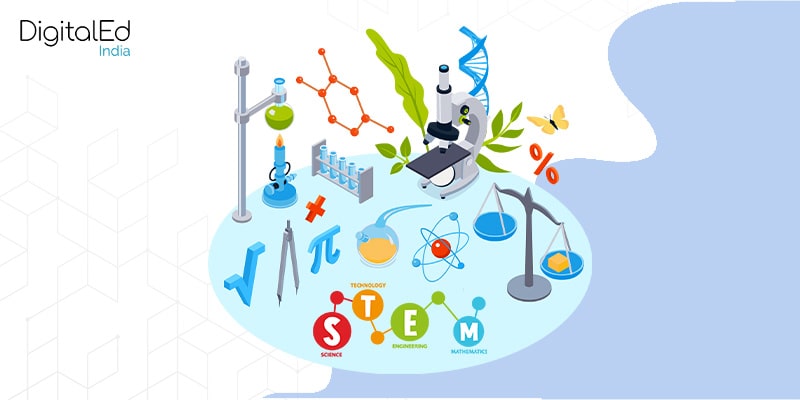STEM Education from an Educator’s Point of View: Problems and Solutions
Barriers that Teachers face while teaching STEM Courses
To learn something, you need a teacher, whichever medium you use. Teachers all over the world have a considerable influence on the level of understanding of a particular topic by a student and the outcome which is generated after education. A quality teacher is indispensable for quality education.

STEM education is a unique approach of education that promises to transform education from mere users of technology to the developers of the same. It provides a departure from the limitations of traditional education to both students and teachers. However, it has been seen that the teachers themselves are not very comfortable with STEM education. Let us see the challenges that teachers face while teaching STEM courses.
Lack of Investment in Teachers’ Professional Development: STEM education is still an emerging approach in the field of education. In such conditions, if a teacher who himself is a student of traditional education, tries to teach students with STEM techniques, he is bound to face challenges. In this context, proper investment to make teachers professionally skilled for STEM courses is especially important.
Lack of Technological Support: Besides being skilled in STEM education, another barrier that teachers face is proper technological support. STEM education follows an applied approach where students learn by doing. This requires an adequate supply of technology and equipment, a lack of which is a hindrance to the desired outcome.
Lack of Interest among Students: Though STEM education is a very promising tool that is transforming education like never before, students sometimes are not able to develop an interest in the classes. This could be either due to an improper educational environment or poor internet connection. In such conditions, there is very little a teacher can do about it and they fail to deliver their best to the students of STEM education.
3 Ways to help a student struggling with STEM Education
- Introduce STEM Education at Young Age: The subjects that STEM education covers include science, technology, engineering, and mathematics. All these subjects need a curious and ready-to-learn mind. That is why; it is important to start STEM education at a youthful age for students.
- Make it Interesting: STEM education must be activity-based. Several activities need to be included such as fun games, quizzes, and interaction in class. Showing something interesting related to studies is the best way to make them learn quickly. It is also helpful in the retention of the subjects learned.
- Project-Based Learning: Students must be given an opportunity to apply their skills to practical use. Giving them projects, such as developing an app or designing a model of a bridge where they can apply for their knowledge work on a project from start to end is a great way to keep them interested.
STEM as a Teaching Strategy
STEM education is a teaching strategy that takes an altogether different route to educate and empower students with the knowledge, compared to what so far we have seen in the traditional form of education. The strategies STEM education uses to impart education include techniques like experimentation, using and developing modern technologies, new test ideas, and innovating and coming up with solutions to complex and real-life problems through EDP (Engineering Design Process).
STEM Teacher
A STEM teacher is an educator who teaches subjects like science, technology, engineering, and mathematics. At their secondary level, they teach anyone STEM subject such as physics or biology with specialization. At the elementary level, the subjects are integrated into one curriculum. This helps students develop a basic understanding of all subjects.
To become a STEM teacher, one needs to pass a test. In this test, one can appear for any of the four subjects she/he is interested in teaching. There are different tests for different subjects.
The duty of a STEM teacher includes developing a STEM curriculum, planning daily lessons, giving tests and assignments to students, and measuring their progress.
Ways to Encourage Students to Take the STEM Strand
1. To encourage students to take the STEM strand, students must be made aware of the wide range of career opportunities that it offers. A student can choose to become a Rollercoaster engineer, Patent attorney, Music machine learning engineer, Storm tracker, Ethical hacker, Robotics engineer, etc.
2. These jobs roles are not only interesting but also going to be high on demand in the coming times.
3. STEM strand prepares a student not to pass the annual school test but to pass real-life tests where they face real problems and need actual solutions.
4. STEM education develops the critical thinking abilities of a student makes him analytical, imaginative, and creative.
Engaging Students in STEM Education
STEM curriculum is based on a learning-by-doing approach, so it is easy to keep STEM students engaged with the studies. There are various ways to keep students engaged in STEM education.
- Provide Hands-On Experience: Give students increased opportunities to use their skills through assignments and experiments. Continue giving them projects that require them to think creatively and go out of the box to think.
- Using Flip Learning: Make effective use of Flip learning practices. This helps students become familiar with subjects beforehand and provides teachers with more time for direct interaction with students.
- Keeping an Eye: Check regularly what students are learning, what their strengths and weaknesses are, can communicate their doubts or not, etc. to keep them engaged in a STEM classroom.
Following these techniques will certainly help teachers to keep students engaged with a STEM classroom.
STEM education is a unique and an innovative approach to education. This article will help teachers deal with their problems related to STEM education better so that they can get the desired results.